AIP, Vegan, Vegetarian, Paleo, Gluten Free, Dairy Free, No Eggs, No Nuts and No Processed Sugar
I can’t eat a normal Green Thai Curry due to having Hashimotos which is a Thyroid disease, so I make my Healthy Green Thai Curry Recipe Gluten Free, Dairy Free, with No Eggs, No Nuts or No Processed Sugar. You don’t have to put meat in, which suits vegetarians and vegans. I put lots of vegetables in mine, with different colours and it’s simple to make. I call this a healthy Green Thai Curry because everything is made from scratch including the paste.
Describe Hashimoto.
Visit my About Me page if you want to learn more about Hashimoto’s.
My immune system targets my thyroid gland as a result of the autoimmune condition known as Hashimoto’s.
Certain meals can exacerbate my symptoms and issues, such as insomnia, low energy, brain fog, anxiety, exhaustion, and constant coldness.
Describe AIP.
I’ve had all of my symptoms my entire life, and I haven’t noticed an improvement until I changed my diet.
I now adhere to a more stringent diet known as the Auto Immune Protocol (AIP), which has assisted me in reducing the inflammation in my stomach and issues related to auto immune disorders.
I completed the AIP diet’s full elimination process a few years ago; if you choose to use it, simply exclude lentils, rice, coriander, cumin seeds, and black pepper from your diet.
I noticed there were no responses when I reintroduced these foods to my diet, so I may use them in my cooking.
Why consume organic foods?
In all of my cooking, I exclusively use organic ingredients that haven’t been treated with pesticides or chemicals. I switched to organic foods to aid with my Hashimoto’s symptoms, but I’d advise everyone to do the same.
I strive to make everything from scratch and eat clean food with few to no chemicals and little to no processed food.
Eating typical food from supermarkets or even farmers markets and not knowing what chemicals are sprayed onto your food can greatly harm your health, especially if you already have health problems like an auto-immune condition.
Food that is organic is fresher, contains more antioxidants and nutrients, and lasts less time because it doesn’t contain any food-preserving chemicals.
The alternate possibility
Describe Coconut Aminos.
Coconut Aminos Naked is made by hand from fermented coconut flower nectar stored in barrels.
A tasty, healthful, and light substitute for soy sauce
Supports women’s empowerment in isolated coastal villages
Ideal for salad dressings, sushi, pork, and stir-fries
How is Green Thai Curry prepared by Thai people?
Thai Green Curry is the food that Thai people love to cook the most.
For this dish, Thai cooks typically utilise fresh green veggies and pork.
Although most people think of chicken when they think of green curry, you may also add beef, shrimp, pork, and fish balls.
Gaeng Keow Wahnin, which translates to “sweet green curry,” is the Thai name for green curry.
Why is curry paste used by people?
Both green and red curries offer the perfect amount of sweetness and heat.
Since green curry paste is readily accessible in stores all around Thailand, most people opt to use it instead of making it from scratch.
Although the heat and sweetness of the meal are relatively balanced in the green curry, there is occasionally a minor dominance of sweet tones. Green curry is just as fiery as its red version.
Thai Green Curry’s ancestry
Thai green curry is thought to have Asian origins, according to history, but the original recipe has undergone many alterations and now incorporates the tastes of many curry fans throughout the world.
These days, this dish comes in a wide variety and is eaten all over the world.
Thais who reside outside of their country of origin spread Thai green curry to other nations.
Traditional ingredients and preparation techniques
These ingredients make up a traditional green Thai curry: coconut milk, green curry paste, sea salt, peas, aubergines, fish sauce, and kaffir leaves.
The texture and thickness are controlled by the use of coconut milk.
Greens such shallots, garlic, mortar green chillies, kaffir lime peel, cumin seeds, galangal, coriander seeds, shrimp paste, salt, and white peppercorn are flattened to create the green paste.
Before adding the green paste to the meat and veggies, fry it in coconut milk.
Different herbs, including Thai basil, phrik chi fa, and kaffir lime leaves, are combined to flavour the curry.
The meat, fish, and beef are added nearer the time of your meal.
Thai Green Curry: Serving and Consuming
I serve my Thai Green Curry with brown rice but most people serve it with steamed rice, or Jasmine rice, Thai rice noodles, coconut rice.
The various curry types
The base ingredients and spices used in all curries, including red, yellow, green, panang, and massaman, are lemongrass, shallots, peppercorns, kaffir lime leaves, cumin seeds, garlic, and shrimp paste.
The sole distinction between the recipes is the colour and amount of additional chillies.
Describe shrimp paste.
An other crucial component used in Thai curries is a shrimp paste with a powerful, savoury flavour.
The krill or tiny shrimp used to make the shrimp paste are salted, dried, and then fermented in the sun.
Due to its ability to be stored for months at a time without needing to be chilled, shrimp paste has been around since the ninth century.
It was the ideal component when fresh food wasn’t going to survive very long.
How come coconut milk is used?
The primary component in Thai curries, the majority of which contain water, is coconut milk.
The sour curry (also known as gaeng som), which is cooked with shrimp paste and a lot of shellfish to flavour the broth, is the most well-known water-based curry in Thailand.
Ghee, a clarified butter that was once used in Indian curries and was handed down through the generations, has recently been replaced by coconut milk.
Making a green Thai curry requires coconut milk since the milk’s sweetness helps to offset the heat from the chiles.
Why create homemade curry paste?
You would be mistaken to believe that the pre-made pastes from the grocery store are healthy because they typically contain more than 40 teaspoons of sugar and a lot of salt.
Additionally, they have chemicals and preservatives to extend their shelf life.
How should homemade curry paste be kept?
Typically, I make a large amount of curry paste and freeze it in glass containers.
The paste keeps for 2 weeks in the refrigerator and 3 to 6 months in the freezer.
I only use glass containers because they can be recycled and don’t wind up in landfills, making them preferable to plastic ones.
Unlike plastic containers, which break down and disintegrate over time, resulting in plastic particles.
Why I use this brand?
Native Forest Coconut Cream organic, is the one I use, and they also make coconut milk. Its 100% coconut and organic, I can’t have other brands because they add water and this one doesn’t add any water.
Healthy Green Thai Curry Recipe – Let’s get started on the paste….
The first step is to make the paste, this recipe takes a couple of hours to make but it’s worth it. The paste can be made the day before or earlier and kept in the fridge or freezer. I can’t have pre made pastes because they have ingredients in them that my body reacts too and I prefer to have no heat. It has zero heat in it but you can make it hot if you like by adding chillies. I like to use fresh lemongrass when its in season, if it’s not available then I use lemongrass that is dried.
First we will make the curry paste, cut up the onion and garlic and fry until slightly brown. Put all the curry paste ingredients into a blender and blend. Add the Thai Curry Paste to the same frying pan and cook for 1 minute. Add the coconut milk, coconut cream, kaffir leaves/powder.
Below is what the Curry Paste should look like.
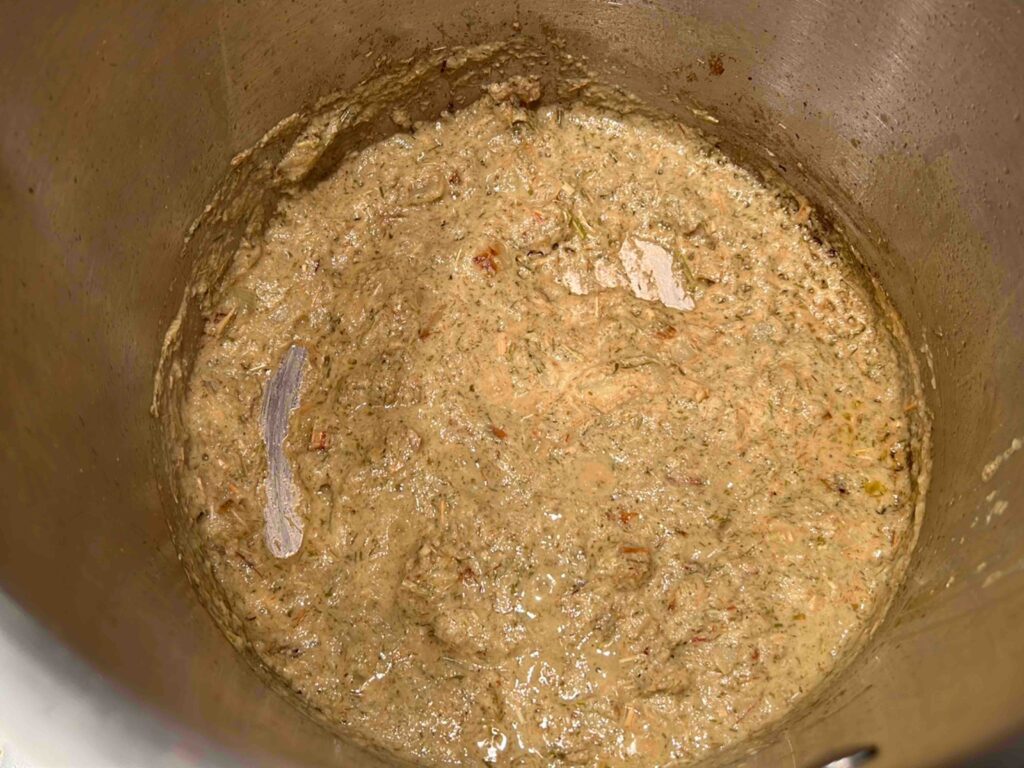
Cut up all vegetables and put in stock pot. Add enough water to cover the vegetables. Cook on high until the liquid is boiling, then turn down to low and cook for an hour with the lid off.
You can also add the lentils but this is optional, it will give the whole dish a boost in nutrients and help thicken the sauce.
Turn off the heat and add the arrowroot flour, if you want it thicker just add a few more tablespoons.
Put the brown rice on half way through and use the absorption method, it usually takes 45 minutes.
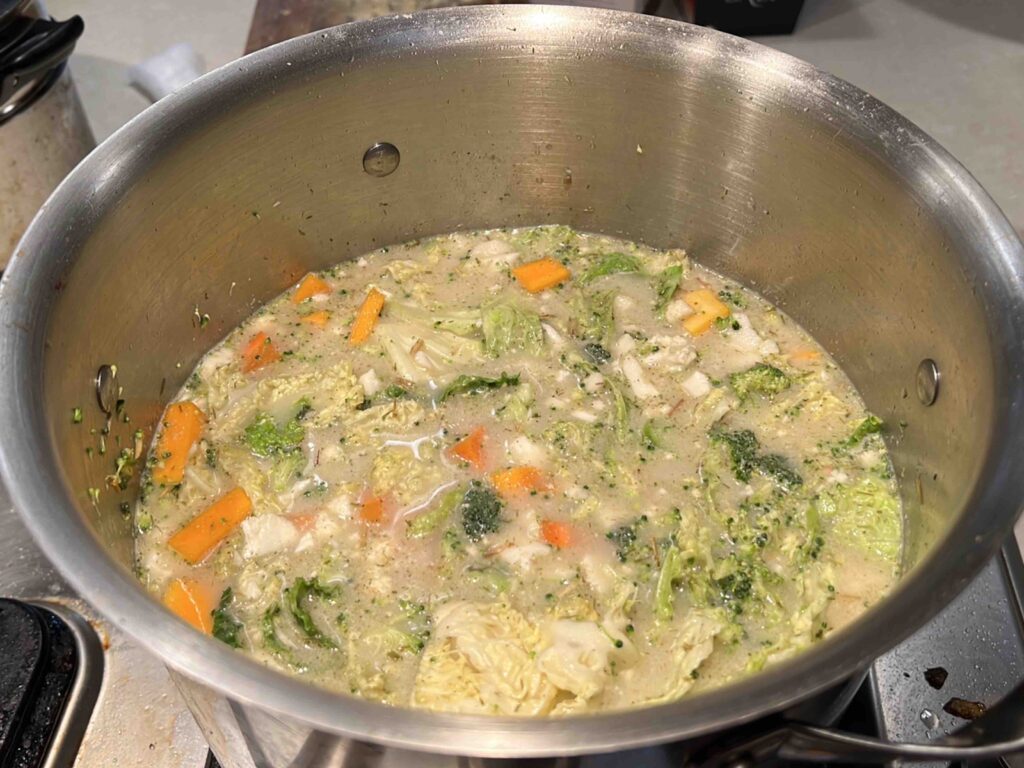
And finally the finished product with papadums that I usually fry in a frying pan with a little olive oil.
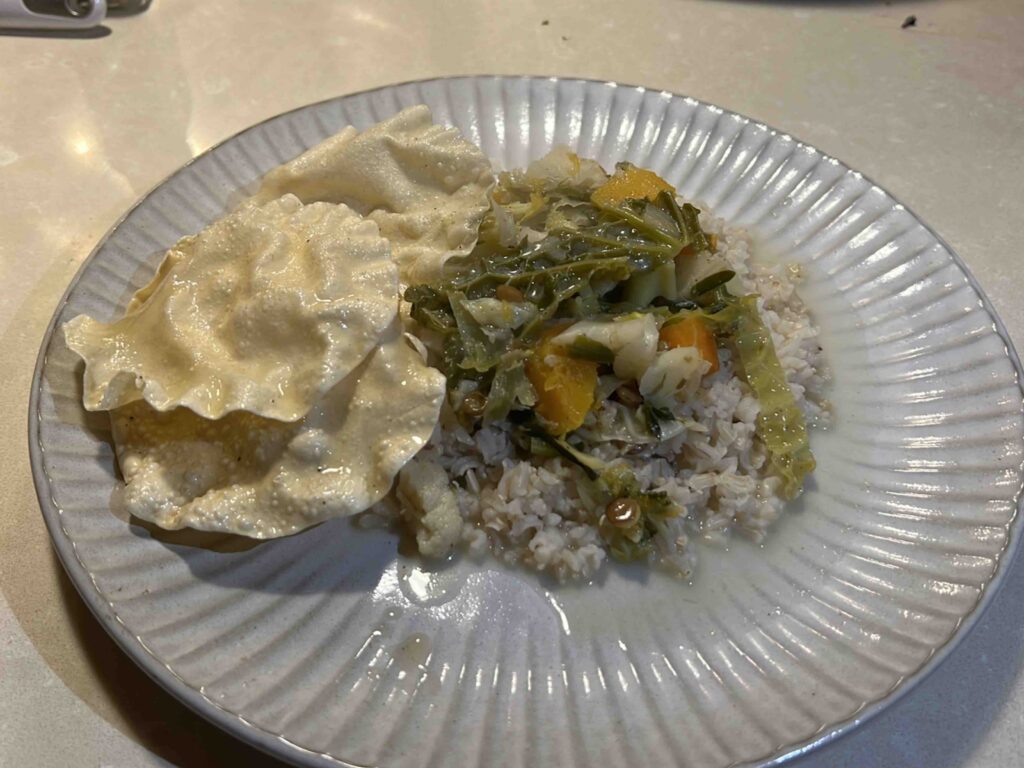
If you like this recipe you will love my other recipes.
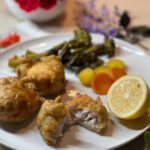
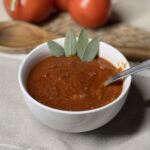
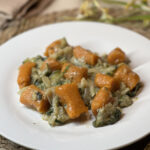



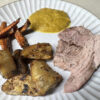
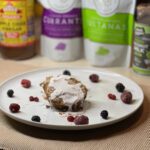
If you try this recipe let me know in the comments below the post.
FOLLOW ME on Facebook, Instagram, Pinterest and Twitter to see more delicious food and get all the latest updates.

Equipment
- 1 Blender
Ingredients
- 2 Carrots
- 1 Broccoli
- ½ Cauliflower
- ½ Butternut pumpkin
- ½ Cabbage
- 5 Brussel sprouts
- 1 zucchini
- 1 cucumber
- ½ tsp Pepper Leave out for AIP
- 1 can Coconut Cream
- 1 tbsp garlic powder
- 1 can Coconut Milk
- 1 tbsp onion powder
- 2 tbsp coconut aminos
- 1 L Water
- 2 Onions 1 onion for Thai Curry Paste
- 2 tbsp lemongrass dried Thai Curry Paste
- ½ tsp White pepper Thai Curry Paste
- 4 Garlic Clove Thai Curry Paste
- 1 portion Ginger Thai Curry Paste
- 2 tbsp Lime juice Thai Curry Paste
- 4 tbsp Coconut milk can Thai Curry Paste
- ½ tsp Salt Thai Curry Paste
- 1 tbsp Basil Thai Curry Paste
- ½ tsp Cumin ground Thai Curry Paste. Leave out for AIP
- ½ tsp Kaffir Lime Powder Thai Curry Paste
- ⅓ cup Lentils optional. Leave out for AIP/Paleo
- 2 Chicken Breasts/Thighs optional. Leave out for Vegan/Vegetarian
Instructions
- Make the Thai Curry Paste first, by putting all ingredients for the paste in a blender and blend
- Cut up second onion and cook in stock pot until slightly brown. Then add Thai Curry Paste and cook for 1 minute. Add the coconut milk, coconut cream, kaffir leaves/powder and water.
- Turn up the heat to high until the liquid starts to boil then turn down to low with the lid off, cook for an hour before adding anything else to the mixture.
- After an hour, cut up all the vegetables and put in the stock pot.
- Cook for another hour or until the vegetables are soft and the liquid has reduced.
- You can also add the lentils but this is optional, it will give the whole dish a boost in nutrients and help thicken the sauce.
- Turn off the heat and add the arrowroot flour, if you want it thicker just add a few more tablespoons.
- Put the brown rice on half way through and use the absorption method, it usually takes 45 minutes
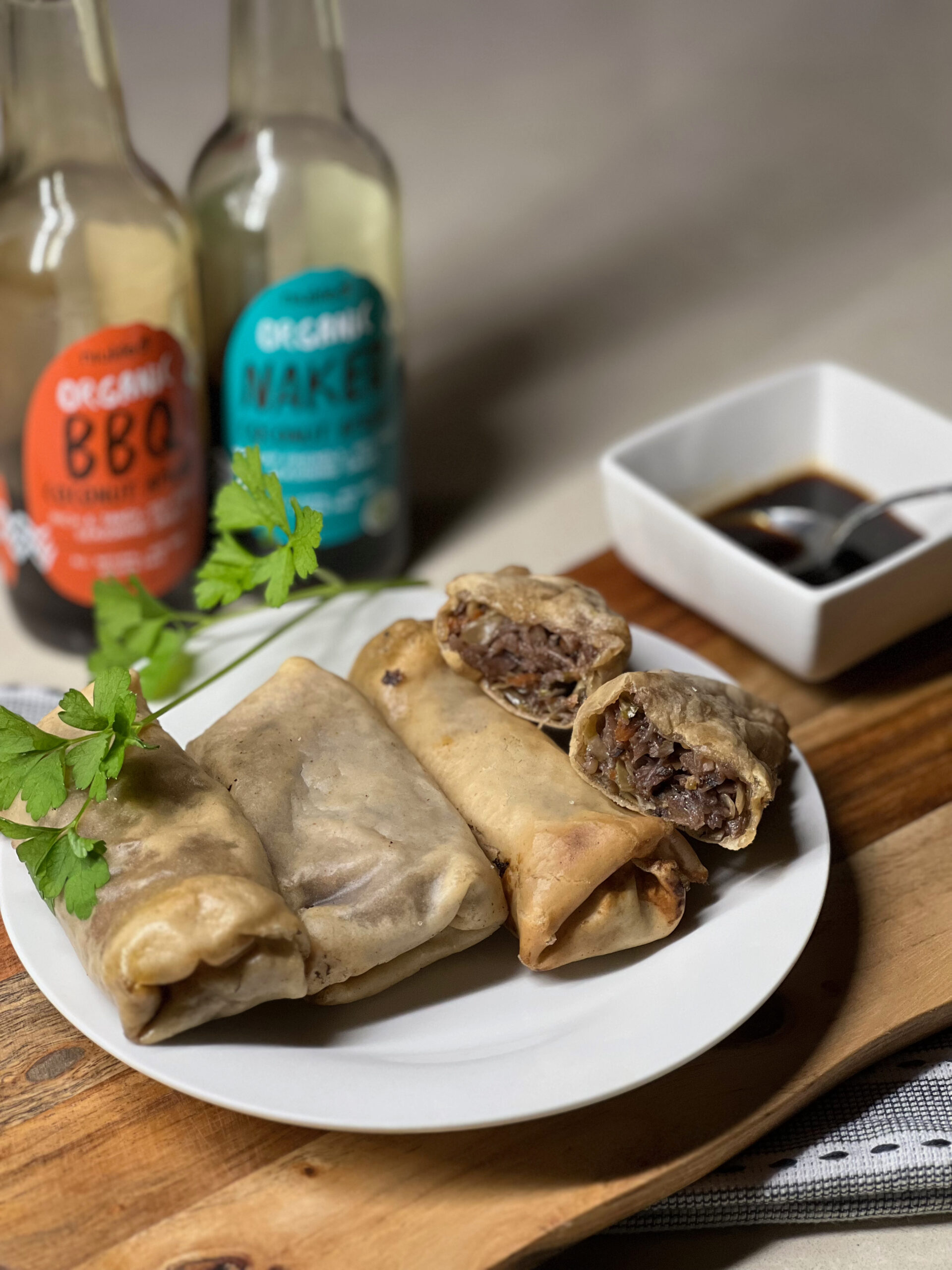
Leave a Reply